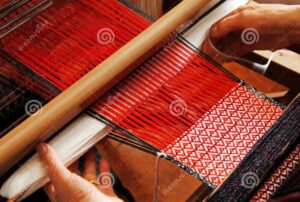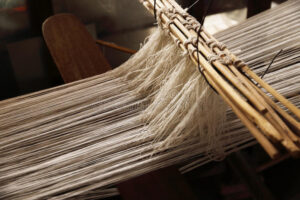Handlooms constitute a timeless aspect of the rich cultural heritage of Sri Lanka. As an economic activity, the handlooms occupy a place providing a livelihood to the people. The element of art and craft present in Sri Lankan handlooms makes it a potential sector for the upper segments of domestic and global market.
Handlooms form a precious part of the generational legacy and illustrates the richness and diversity of our culture and the artistry of the weavers. Handloom is supreme in its flexibility and versatility, permitting experimentation and encouraging innovation. Weavers with their skillful blending of myths, symbols and imagery provide their fabric an appealing dynamism. The strength of Handlooms lies in innovative design, which cannot be replicated by the ordinary.
Sri Lanka has a historical connection to handlooms and portrays generously in local myths and legends. With records of Sri Lanka trading vividly designed cotton textiles, as far as 1000 years ago, the country has been known as a hotspot of textile manufacturing.
Sri Lankan handloom industry is mostly carried out in a cottage industry level, with few large manufacturers leading the way. An industry governed largely by women, the Sri Lankan heritage and traditional weaving patterns are kept alive. The Sri Lankan handlooms are made of cotton and silk threads and many are presented as sarees, shawls, sarongs as well as household linen, upholstery, tapestry, and curtain fabrics. Exported around the world and could be purchased under local brands as traditional handlooms of Sri Lanka continuing to add colour to many living spaces around the country.
The elegance of locally handcrafted clothing, the vibrancy of the woven designs along with , the innovative colour combinations which is added to the fabrics adding on to Sri Lanka’s centuries old handloom textile industry.
The industry has assisted to showcase the undying creativity of generations of Sri Lankans taking them even to the international arena.
The mix of manufacturers which includes leading handloom weaving manufacturers , together with small scale producers along With the help of factories, some small scale weavers have been given an opportunity to showcase their talents and penetrate easily to the international markets. A range of attractive designs with vibrant colours are on offer adding on with individual and innovative designs, craftsmanship, colour combination and patterns are handed down from generation to generation.
These items are designed for niche markets where handmade products of high value are required for purchasing.
Awareness of modern design trends are always kept a tab on and its been , combined with traditional craftsmanship and the influx of new processing techniques are frequently incorporated to the Sri Lankan handlooms which has been given a new life to its creativity. The industry has gained a dominant identity in the market and reaching even the competitive international market.
However handloom weaving is a skilled profession as we are aware which requires patience, innovation and continuous alertness so that the design which is created is perfect as an end result.
Handloom products are assured with complete sustainability and with minimal environmental pollution. Therefore, there is a great opportunity for the Sri Lankan handloom industry to flourish. Development of the industry would reduce the flow of imported material to the local market and could save valuable foreign exchange while the local industry keeps strengthening.
Most developing nations around the world harness the potential of the country’s native creative industries in gaining economic development and empowering craftsman communities, which is easily , possibly done with an industry such as Handloom.
Sri Lanka certainly has a rich history of traditional craft-based industries including textile crafts such as handloom textiles since the country’s close association with global fashion and apparel industries. The Handloom sector is a highly labour-intensive industry, it plays a vital role in reducing poverty. The industry is mostly located in rural areas.
According to the Mahavamsa, Princess Kuweni, the native princess of Sri Lanka was busy using her weaving wheel when prince Wijaya arrived in Sri Lanka. According to records, cotton has been in trade between Sri Lanka and other countries. The current designs also exhibit characteristics of Indian and Egypt art that is believed to be passed down back in the day.
The Sri Lankan handloom industry mainly comprises three main segments namely community-business, provincial council-based handloom business, and private business. Independent weavers who work within the context of areas that are dedicated to the industry are considered under community business. Production centres owned by the provisional councils and private owners are scattered across various parts of the country. These weavers are focused on both local markets and export markets. Most of their products include sarees, other womenswear, menswear, curtains, bed covers, cushion covers, bed covers, toys, and other accessories.
The industry has helped the country to develop sustainable employment opportunities during the process of rebuilding industries for a better tomorrow. The high demand for environmentally and socially friendly products allowed local producers to show off their talents by delivering high-quality products to global markets impressing the true Sri Lankan creativity to the intentional markets as well.
The local industry is in a capacity to supply for both small and large quantities when it comes to addressing demand which is required in the market. Sri Lanka is also known to be a country that comprises raw materials for the industry of handloom. This is a great strength to a low-cost involved industry such as handlooms for the potential investors and the work force to be involved in.
The employment opportunities that are offered to the rural communities provide them with a source of livelihood promising a hope towards their future. Handlooms require low capital investments initially. This reduces a lot of costs and attracts more investment opportunities towards the sector.
If you were to ever visit a handloom workshop, you will see meditative artists weaving on their handlooms. Mostly elderly ladies, coordinate the use of their eye, hands, feet and mind in perfection and the outcome is beautiful yards of colorful textile. The life of these cotton textiles begins with the dyeing of 100% cotton yarn into vibrant colors only limited by your imagination. Their journey takes us next to the handloom workshops. First the dyed yarn is spun into bobbins that are then used to create the warp, which dictates the design of the length of the fabric.
Sri Lankan weavers have succeeded in fashioning a distinctive identity of their own by converting the traditional woven patterns and color schemes into the beautiful modern textile designs always striving to add glamour to its creations. Nature also is a form which inspires the forms and patterns. Many of the motifs on the traditional handloom textiles are inspired by the environment.
It’s no secret that we have taken a true attraction towards Sri Lankan handlooms; Everything beginning from its colours, textures, materials and methods as to how the weavers have created where the fascination continues. The creative designs are caught between their threads this oldest textile craft has kept alive through generational knowledge creating more and more to our heritage.
This industry is certainly a part of our rich Sri Lankan culture which promises many with employment and promises the textile industry with its unique innovative creativity adding a true Sri Lankan spirit .
